
Recent developments in international space exploration plans for Mars have inadvertently placed the UAE’s Hope Mars Mission in the forefront, and impact the future of UAE’s space exploration ambitions. ThorGroup’s Chairman and President, Dr. John B. Sheldon, explains.
Without even knowing or asking for it, the past several weeks have indirectly placed the United Arab Emirates’ (UAE) Hope Mars Mission in the international spotlight.
Through no fault of its own, the UAE Space Agency now finds itself one of only a tiny handful of space agencies – India and China being the others – undertaking missions to Mars around the 2020 timeframe.
The latest budget of the US space agency, the National Aeronautics and Space Administration (NASA), has allocated hardly any money at all for its Mars exploration plans. As a result, it is increasingly unlikely that the United States will be able to fulfill its near-term plans to send scientific missions to Mars, with the possible exception of its InSight mission currently set to be launched in 2018. In effect, NASA’s budget for Mars exploration over the coming years has been hollowed out by politicians who have given the lion’s share of the 2017 NASA budget to the development of its heavy lift Space Launch System (SLS) rocket that will restore America’s ability to launch its own astronauts. Currently, the United States relies on Russia to launch its astronauts to the International Space Station (ISS).
At the same time, the joint RosCosmos (Russia’s space agency)-European Space Agency (ESA) ExoMars Mission that was originally scheduled to be launched in 2018 is now postponed until at least 2020 due to technical problems and savage cuts to the Russian space budget. This setback comes on the heels of the successful launch of the first RosCosmos-ESA ExoMars mission earlier this year.
The full analysis is available as a paid download for 2.99 USD. If you are interested, please send us an e-mail stating the desired document to [email protected]
 SpaceWatch.Global An independent perspective on space
SpaceWatch.Global An independent perspective on space

